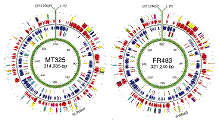Virology, Nebraska Center for
Document Type
Article
Date of this Version
2016
Citation
J. Virol. doi:10.1128/JVI.01215-16
Abstract
Binding of HIV-1 and SIV gp120 exterior envelope glycoprotein to CD4 triggers conformational changes in gp120 that promote its interaction with one of the chemokine receptors, usually CCR5, ultimately leading to gp41-mediated virus-cell membrane fusion and entry. We previously described that topological Layers (Layer 1, Layer 2 and Layer 3) in the gp120 inner domain contribute to gp120-trimer association in the unliganded state but also help secure CD4 binding. Relative to Layer 1 of HIV-1 gp120, the SIVmac239 gp120 Layer 1 plays a more prominent role in maintaining gp120-trimer association but is minimally involved in promoting CD4 binding, which could be explained by the existence of a well-conserved Tryptophan 375 (Trp 375) in HIV-2/SIVsmm. Here we investigated the role of SIV Layer 3 on viral entry, cell-to-cell fusion and CD4 binding. We observed that a network of interactions involving some residues of the β8-α5 region in SIVmac239 Layer 3 may contribute to CD4 binding by helping shape the nearby Phe 43 cavity which directly contacts CD4. In summary, our results suggest that SIV Layer 3 has a greater impact on CD4 binding than in HIV-1. This work defines lineage-specific differences in Layer 3 from HIV-1 and SIV.
Included in
Biological Phenomena, Cell Phenomena, and Immunity Commons, Cell and Developmental Biology Commons, Genetics and Genomics Commons, Infectious Disease Commons, Medical Immunology Commons, Medical Pathology Commons, Virology Commons


Comments
Copyright © 2016, American Society for Microbiology. All Rights Reserved.